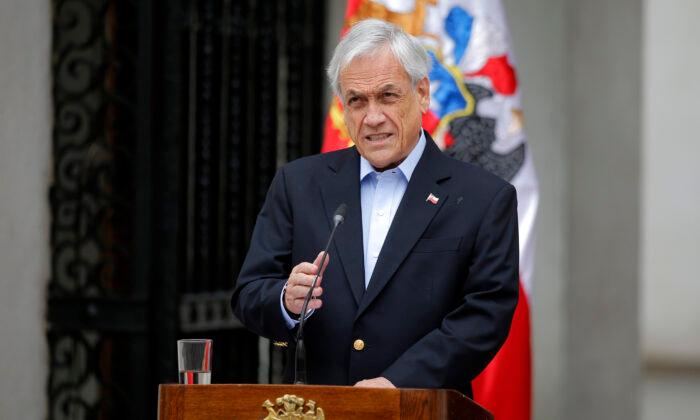Peru’s Congress filed a motion to impeach President Pedro Castillo on Nov. 25, which political rival Keiko Fujimori and her Popular Force party supported.
Castillo’s administration has been plagued by scandal and corruption charges since he took office this summer.
The Nov. 25 impeachment motion makes Peru the third South American nation since October to consider removing its president.
Chile’s President Sebastián Piñera faced impeachment by the lower chamber of the nation’s legislature on Nov. 9 due to his involvement in a questionable acquisition exposed in the Pandora Papers investigation.
The action failed to pass the Senate due to a lack of opposition votes on Nov. 16.
In Ecuador, President Guillermo Lasso faced a congressional investigation for tax evasion, likewise revealed in the Pandora Papers. Former presidential candidate Andrés Arauz called for Lasso to resign from office on Oct. 7.
Neither Side Was Happy With Piñera
“People were unhappy with Piñera because of the social unrest situation back in 2019,” South America political analyst and New York University professor Patricio Navia told The Epoch Times’ “Insight” magazine.Widespread protests and unrest broke out in Chile in October 2019 over the announcement of an increase in public transit fees.
Both conservatives and liberals were unhappy with the way Piñera handled the government’s response to the upheaval.
In response to his diminished approval ratings following the 2019 protests, Piñera said, “I understand that Chileans are not happy with what has happened. I am not happy either.”
Conservatives felt the president’s response wasn’t effective, and liberals decried the use of excessive force by the police against unarmed demonstrators.
As of September, Piñera’s approval rating fell to 26 percent due to unfulfilled voter expectations and ineffectual policies.
“The Pandora Papers were just an excuse [for impeachment],” Navia said.
Peru’s Pandemic Fumble
Peru has the distinction of having the highest per-capita death rate from the CCP (Chinese Communist Party) virus in the world, which factors into the chaos surrounding Castillo’s impeachment.Overall discontent with the way the state responded to the pandemic, combined with slow economic recovery and the government’s use of the less-effective Chinese Sinopharm vaccine, cast a shadow over the new president.
The CCP virus, commonly known as the novel coronavirus, is the pathogen that causes COVID-19.
Among the official reasons listed by Congress as grounds for Castillo’s removal are the illegal use of public funds by members of the Peru Libre party and the president’s appointment of officials currently under investigation for suspected ties to terrorism.
Parallels Between Ecuador and Peru
Lasso and Castillo both represent egress from the legacy of a stigmatized predecessor.In the case of Ecuador, Lasso is the first right-wing leader in 14 years and is emblematic of the departure from the corruption and scandals of former democratic socialist President Rafael Correa.
Correa was sentenced to eight years in prison for a bribery scandal in September 2020.
In Peru, Castillo was the only front-runner candidate besides Keiko Fujimori, the daughter of controversial former President Alberto Fujimori, who was accused of crimes against humanity during his tenure and is currently serving a 25-year sentence in prison.
This mentality among voters creates what Navia calls a “rebound effect.”
He highlighted that choosing presidential candidates from a “lesser of evils” perspective doesn’t lay a foundation for stability in any nation.
Undermining Democratic Values
Aside from being an avowed Marxist-Leninist, Castillo’s first speech as president in July singularly addressed a handful of indigenous communities, leaving some Peruvians with the impression he had little interest in representing the nation as a whole.This set the tone for what escalated into his impeachment.
Chilean political science professor Christopher Martinez says that, paradoxically, presidential failures occur when leaders are forcibly removed from office.
Navia echos this sentiment and believes impeachments and protests undermine the logic of basic democratic values, saying it’s merely a way to circumvent the polls.
“Democratic values and institutions must be respected,” Navia said.
A Common Denominator: Inequality
Peruvian political analyst Alberto Adrianzén said his nation is not only divided by politics, but also by segregation and inequality.The 20th-century solution to this problem in Latin America was land distribution. Through this method, the economically disadvantaged had a chance to become part of the middle class.
Today, education reform appears to be the modern equivalent and was called a “social equalizer” by the National Institute for the Evaluation of Education in Mexico.
Inequality and instability in Latin American politics go hand in hand, much of which comes from ongoing trust issues between the civilian population and their governments, according to an Inter-American Development Bank study.
Martinez noted that since 1979, one in every six South American presidents has failed to complete their constitutional term.





